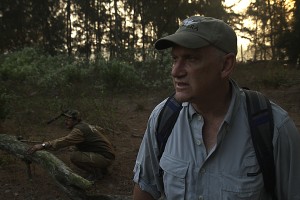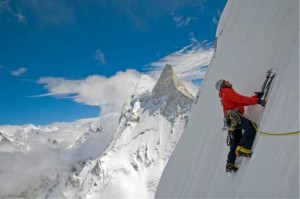During its 4 day run, Durham, North Carolina’s Full Frame Documentary Film Festival generously offers over seventy movies. For my part, I aim to furnish capsule reviews for 10 of those films.
For the first film, (Dis)Honesty – The Truth About Lies, I’ll keep my comments especially brief, since Evan Cogswell plans to post his own full-length review on this blog in the coming days.
For a documentary about the human proclivity towards self-deception and lies towards others, (Dis)Honesty pleasantly surprises with its light, playful tone. The research (and considerable charm) of behavioral economist Dan Ariely form the center of this film. Radiating outward, as spokes on this narrative wheel, are the autobiographies of ordinary people’s fabrications. These tales illustrate Ariely’s key points about the psychological gymnastics that our brains undergo in fibbing, rationalizing, and self-justifying.
Ariely’s data convinces in revealing the universality of deception across cultures, religions, and genders. This may sound like a bitter pill to swallow, but it’s made much sweeter by Ariely and the filmmakers’ winsome sense of humor and nonjudgmental tone. Hope is offered, too, with some simple correctives that can put the brakes on our lying ways. Besides, researchers posit that some degree of confabulation may be necessary for our brain’s development in childhood!

Tiger Tiger takes us away from MRI’s and research labs, and situates us in the vast mangrove forests of South Asia. Here, big cat biologist and wildlife conservationist Alan Rabinowitz is surveying a region that may hold one of the world’s largest remaining tiger populations.
Tragically, our globe may only contain about 3000 tigers at present. Purchasers of black market Chinese medicine, as well as subsistence level farmers and fisherman killing off predators, threaten to drag this number still lower.
In Tiger Tiger, we follow Rabinowitz as he trudges and boats around the Sundarbans region that straddles the border of India and Bangladesh. While striving to survey the area’s tiger population, he meets with villagers (some who have lost multiple family members to tiger ambushes), fellow researchers, and local animal advocates.
Rabinowitz cuts a fascinating figure. He has the face and build of a pugnacious boxer (and indeed, Tiger Tiger opens with his kickboxing exercise regimen). He is a romantic adventurer, passionate in his endeavors. He’s highly empathic, praising the efforts of his colleagues while caring not only for the local felines, but about the wellbeing of impoverished humans of the Sundarbans. Yet he is also a relentless empiricist, ever questing for hard data to back his efforts.
Tragically, while Rabinowitz pushes back against the extinction of tigers worldwide, he’s also staring at his own mortality. We learn early in the film that Rabinowitz has incurable leukemia, and this may be his last overseas foray.
Tiger Tiger’s director, George Butler, is an old hand at documentary film-making. His curriculum vitae extends back to 1977’s Pumping Iron, the body-building movie starring an Austrian chap named Arnold Schwarzenegger. Unfortunately, that doesn’t stop Butler’s latest film from dragging and meandering in a couple of places.
However, a vivid central character and amazing imagery still make this an above average film. In the Q&A following today’s screening, Butler informed the audience that his camera crew lingered forty days in the mangrove forests. Their persistence paid off richly, with incredible close-ups not only of tigers (including goofy kittens), but of wild pigs, crocodiles, birds, and lizards. Additionally, judicious insertion of aerial shots from camera drones reveal the vastness of the Sundarbans wilderness.

My last film of the evening, Meru, transported us from sea level India to a high Himalayan peak. Meru shows us three veteran climbers fighting to reach a summit as yet untouched by human feet.
The central peak of Mount Meru, also known as the Shark’s Fin because of its distinctive shape, pierces the sky at 20,000 feet above sea level. Reaching the top is a punishing challenge that involves running a gauntlet of ice, vertical rock faces, and avalanches, not to mention the risks of frostbite, starvation, and trench foot.
Meru drops us quickly and forcefully into the 2008 ascent attempt by Conrad Anker, Jimmy Chin, and Renan Ozturk. Exposition and biographical background emerges in bits and pieces, as we learn about losses, grievous injuries, and psychological wounds that inform their endeavor. (By 2008, Anker and Chin had been intimate climbing buddies for seven years, while Ozturk was more of an unknown quantity to them, a “climbing bum” who earned a reputation for smart, daring scrambles atop buttes of the American Southwest.)
Impressively, Chin is not only one of the mountaineers, but also a co-director of Meru. As a professional photographer and videographer, Chin’s work has graced the covers of National Geographic and Outside magazines. The camerawork here offers spectacular views of the climb, with many gasp-inducing downward gazes to the deadly drop below, as well as dizzying looks at the looming heights.
Equally crucially, Chin and his co-director Elizabeth Chai Vasarhelyi know how to pace a story. The suspense and human interest are excellently sustained across the entire course of Meru. Superb outdoor writer Jon Krakauer (Into the Woods, Into Thin Air) is helpfully recruited for color commentary, telling us for instance why the Meru ascent is tougher even than Everest (no Sherpas, for one thing).
I must confess that some of the clichéd climber lingo did grate on me at times. I was ready to pull my hair out if I heard one more “gnarly” or another blindingly obvious truism. “Climbing’s a really dangerous sport.” Who knew?
However, just as Rabinowitz’s character makes up for the lacks in Tiger Tiger, the virtues of the trio in Meru more than compensate for the occasional surfer dude-esque verbiage. Just as our world needs more data-driven humanists like Rabinowitz, we can all learn from Meru’s perseverance, camaraderie, and good cheer in the face of heavy adversity.
(Dis)Honesty – The Truth About Lying: 4 out of 5 stars
Tiger Tiger: 4 out of 5 stars
Meru: 4.5 out of 5 stars













